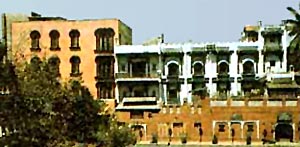 Located in Pune, Maharashtra, India, the Raja Dinkar Kelkar Museum reflects the passion and dedication of Dr. Dinkar G. Kelkar (1896–1990), who curated a remarkable collection dedicated to the memory of his son, Raja. This three-storey museum holds a diverse array of artifacts, ranging from sculptures dating back to the 14th century to intricate ornaments crafted from ivory, silver, and gold. With an extensive collection of musical instruments, war weapons, vessels, and other everyday objects, the museum offers a captivating glimpse into the rich cultural heritage of India.
Located in Pune, Maharashtra, India, the Raja Dinkar Kelkar Museum reflects the passion and dedication of Dr. Dinkar G. Kelkar (1896–1990), who curated a remarkable collection dedicated to the memory of his son, Raja. This three-storey museum holds a diverse array of artifacts, ranging from sculptures dating back to the 14th century to intricate ornaments crafted from ivory, silver, and gold. With an extensive collection of musical instruments, war weapons, vessels, and other everyday objects, the museum offers a captivating glimpse into the rich cultural heritage of India.
History of Raja Dinkar Kelkar Museum
The origins of the Raja Dinkar Kelkar Museum trace back to the early 1920s when Dr. Dinkar Kelkar embarked on a quest to collect artifacts that reflected the essence of Indian culture and craftsmanship. Over the years, his collection grew substantially, encompassing around 15,000 objects by the 1960s. In 1962, the museum was formally established, and Dr. Kelkar generously donated his collection to the Government of Maharashtra in 1975.
Driven by a deep-seated passion for art and history, Dr. Kelkar traversed the length and breadth of India, scouring remote villages, tribal settlements, temples, and humble abodes in search of hidden treasures. His relentless pursuit of artistry and craftsmanship led to the creation of a museum that now boasts over 20,000 artifacts, with 2,500 items on display.
Legacy of Dr. Dinkar Kelkar
Dr. Dinkar Kelkar, affectionately known as `Kaka,` was a visionary who recognized the beauty and significance of everyday objects. Despite his professional background as an optician, his true calling lay in the realm of history and art. Inspired by his love for poetry and history, Dr. Kelkar embarked on a lifelong journey to preserve India`s cultural heritage.
The museum, initially named "Raja Sangraha" and later renamed in honor of Dr. Kelkar and his son, Raja, stands as a tribute to his unwavering dedication. Driven by an innate desire to unearth the extraordinary in the ordinary, Dr. Kelkar meticulously collected artifacts that encapsulated the essence of Indian life and tradition.
Collection at Raja Dinkar Kelkar Museum
The Raja Dinkar Kelkar Museum houses an eclectic assortment of artifacts that reflect the rich tapestry of Indian culture. From intricately carved wooden doors and windows to ornate kitchen utensils, the museum offers a comprehensive glimpse into the daily lives of Indian communities. The Gujarat Gallery, Kitchen Utensils Gallery, Textile Gallery, and Lamp Gallery showcase the ingenuity and craftsmanship of Indian artisans through the ages.
The museum`s collection also includes a diverse array of musical instruments, ivory carvings, arms and armor, bronze sculptures, and puppetry, highlighting the multifaceted nature of Indian artistic expression. Each artifact tells a story of innovation, tradition, and creativity, underscoring the remarkable ingenuity of its creators.
Despite the challenges and sacrifices involved, Dr. Dinkar Kelkar`s singular dedication to preserving India`s cultural heritage has earned him widespread recognition and acclaim. His selfless contribution to the field of museology has been honored by the Government of India and esteemed institutions worldwide.
The Raja Dinkar Kelkar Museum stands as a testament to Dr. Kelkar`s indomitable spirit and enduring legacy. Through his tireless efforts, he has ensured that future generations have the opportunity to appreciate and celebrate the rich cultural heritage of India.
As visitors wander through the halls of the Raja Dinkar Kelkar Museum, they are transported on a journey through time, exploring the vibrant tapestry of Indian art, culture, and tradition. Dr. Dinkar Kelkar`s extraordinary vision and passion have transformed a personal collection into a priceless treasure trove that continues to inspire and awe visitors from around the world.



















